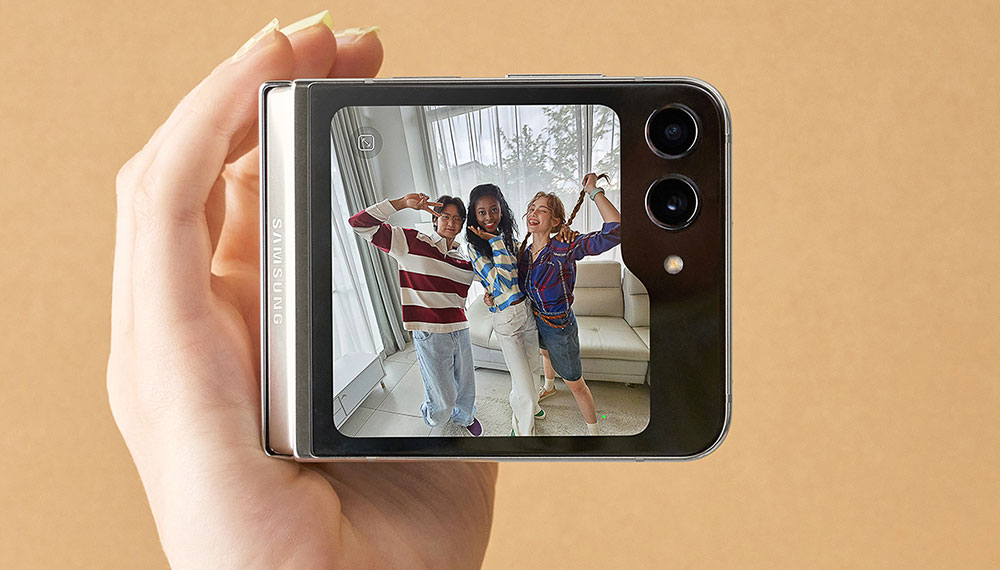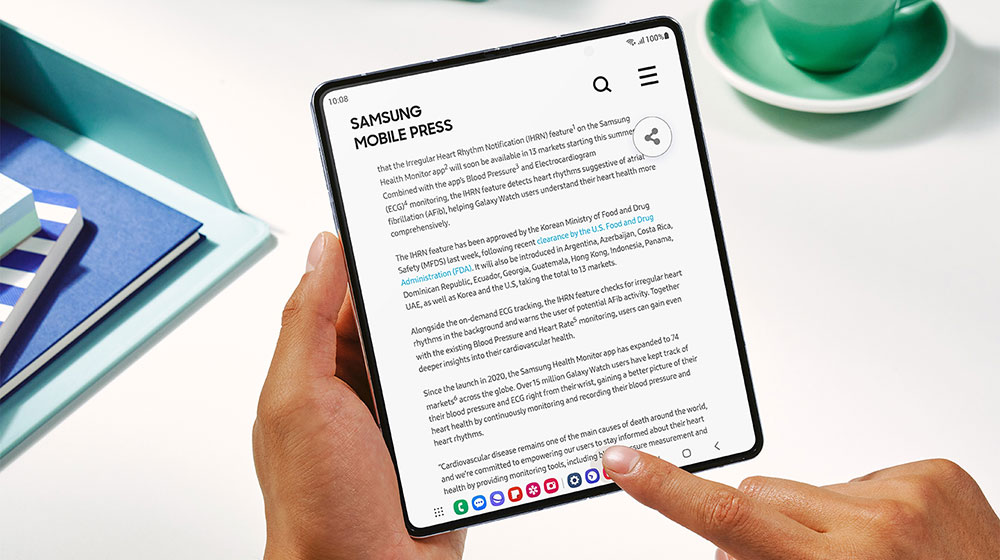In recent years, several foldable designs have aimed to capture a sizable portion of the mobile phone market in this category. However, despite their potential, foldables’ market share has remained in the lower single digits compared to non-foldable designs.
Apple’s dominant position in the smartphone industry, especially in the high-end segment where the tech giant has not yet ventured into the foldable space, partly attributes to the challenges foldable phones face in gaining widespread consumer adoption.
Early foldable gadgets were more of a gimmick than an appealing choice for most people and came at a high premium price.
Now, the industry may have reached a turning point with the launch of the new Samsung Galaxy Z Flip5 and Z Fold5 at last week’s Galaxy Unpacked event in Seoul, Korea, and the availability of other steadfast products like the Google Pixel Fold.
New Hinge Design
Specific details of the new Samsung Galaxy smartphones’ specifications are available online, so it makes little sense for me to dwell on speeds and feeds. Numerous reviews will undoubtedly become available over the next few weeks.
What sets these new foldables apart are the updated design of the hinge — a critical weakness in legacy models — and the screen. These advancements transform the devices into sleek, flat smart gadgets, no longer resembling bulky smartphones that are challenging to store in a pocket.

Featuring an updated hinge design and sleek screen, Samsung’s new Galaxy Z Flip5 foldable transforms from a bulky smartphone into a slim, pocket-friendly gadget. (Image Credit: Samsung)
Watch for these iterations to increase consumer appeal, especially for businesspeople buying premium devices.
Enhanced User Experience
Foldable devices offer numerous benefits to users, primarily through their ability to exploit multiple displays, enhancing the overall user experience. Particularly for those seeking genuine multitasking capabilities, the convenience of having several apps open simultaneously is a key selling point of these gadgets.

The Galaxy Z Fold5 has an immersive, large screen and an improved taskbar that enables dynamic productivity by allowing users to switch quickly between frequently used apps. (Image Credit: Samsung)
Utilizing these devices’ features has become significantly more straightforward, thanks to enhanced user interfaces and improved experiences powered by advanced AI features running on the new and potent Qualcomm processors integrated into these devices.
This seamless integration of cutting-edge technology facilitates onboard assistance, making the learning curve much less arduous for users.
Market Challenges
The market-share challenge for these gadgets lies in their premium price tags, often exceeding $1,700. Nevertheless, the prevailing trend of purchasing phones over $1,000, even if it alienates cost-conscious buyers, indicates a shift in consumer behavior.
Due to these factors, this generation of devices holds considerably greater appeal for a broader range of users than its predecessors. The affordability factor has also significantly improved, making them more accessible to a larger consumer market.
Can Samsung Shift the Market by Itself?
With that in mind, I do not believe foldables will challenge the supremacy of the typical, flat, high-end smartphone. In my estimation, they are not the ideal choice for all users.
However, we may be at a point where a quarter of the overall market will be fairly interested in these gadgets, especially those interested in the advantages of a “fold and flex” design.
Given the preference for premium phone devices and carriers’ ability to make the purchase less painful via customer subsidy programs, it might take at least a couple of years and perhaps another generation or two of foldables to reach higher market share penetration.
Still, I suspect we’ll see a significant uptake of foldable devices. Given that Samsung currently holds a dominant market position for Android-based devices, it should maintain a leadership position in the foldables market.
Apple Is the Wild Card in the Foldables Sweepstakes
In the fast-paced world of smartphone technology, innovation is the key to success.
Among the latest advancements is the foldable smartphone, which holds great promise but has yet to achieve mainstream acceptance.
Samsung, a pioneer in the development of foldable devices, needs Apple, its biggest competitor, to announce a foldable smartphone to legitimize this unique form factor for the wider mainstream consumer audience.
While Apple may be a latecomer to the foldables category, the usage models it creates will set the industry’s tone.
Historically, Apple’s product launches have profoundly influenced consumer trends and guided the direction of the entire industry. When Apple enters the foldables market, it will have a discernible impact on market legitimization and be a game-changer.
Apple’s ability to reach millions of loyal customers and generate unprecedented media attention would undoubtedly bring the concept of foldable smartphones into the mainstream.
Once Apple embraces the foldable form factor, consumers who may have been skeptical or hesitant to adopt new technology will be more inclined to explore foldable devices’ potential benefits and functionalities. The “gimmick” perception will most likely dissipate.
Additionally, an entry by Apple into the foldables smartphone space will enhance consumer confidence, mitigating the perception that hinge designs can easily suffer breakage or damage. Apple’s reputation for high-quality products and exceptional user experience will instill confidence in the minds of potential buyers.
As foldable smartphones are a relatively new concept, concerns about durability and longevity have been raised. Apple’s seal of approval and its meticulous quality control measures will assure consumers that foldable smartphones are reliable and ready for everyday use, encouraging them to take the plunge into this cutting-edge technology.
Apple’s Ecosystem Advantage
Ecosystem integration will be a significant tailwind should Apple jump into the foldables smartphone market. The introduction of a foldable smartphone by Apple would lead to a more robust ecosystem that extends beyond smartphones to iPads, MacBooks, and other Apple devices.
This holistic approach would create new possibilities for developers to optimize their applications for foldable screens, thereby enriching the overall user experience.
As a result, consumers would find added value in the foldable form factor and be more likely to embrace it.
Folding the Future: A New Chapter in Smartphone Innovation
Samsung and Apple have long been engaged in fierce competition, pushing each other to innovate in the smartphone industry.
Apple’s announcement of a foldable smartphone would prompt Samsung to up its game, leading to faster advancements in foldable technology, benefiting consumers with feature-rich devices.
An entry by Apple into the foldable smartphone market would increase demand, attracting more manufacturers and developers, resulting in a broader range of foldable devices and applications.
As the market matures, costs will likely decrease, making foldable smartphones more affordable and accessible to a wider audience.
Samsung deserves credit for its yeoman’s work in creating compelling usage models that exploit the multi-screen dynamic of its new foldable designs. The new Flex Window feature of the Galaxy Z Flip5 phone offers true convenience and innovation when users prop it up in various ways.
The Apple Effect on Samsung Foldable Success
Yet, the company probably won’t get the credit it deserves when Apple releases its foldable design with presumably equally compelling capabilities. That dynamic must be endlessly frustrating for Samsung, given Apple’s ability to capture the imagination of the technology-buying public, even when Apple is late to market.
Regardless, Samsung needs Apple to announce a foldable smartphone to legitimize this form factor for the wider mainstream consumer audience due to Apple’s influential role in shaping market trends, enhancing consumer confidence, ecosystem integration, competitive drive, and fostering market growth and maturity.
While Samsung has been at the forefront of foldable device development, Apple’s entry into this segment would benefit the entire industry significantly. The symbiotic relationship between the two tech giants could revolutionize the smartphone landscape and drive the adoption of foldable smartphones to new heights.
Although Apple is unlikely to announce a foldable design this year when it refreshes its smartphone lineup in September, Samsung might be wishing it was.

























































